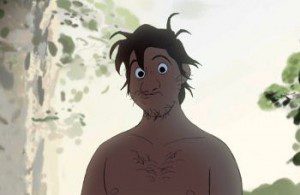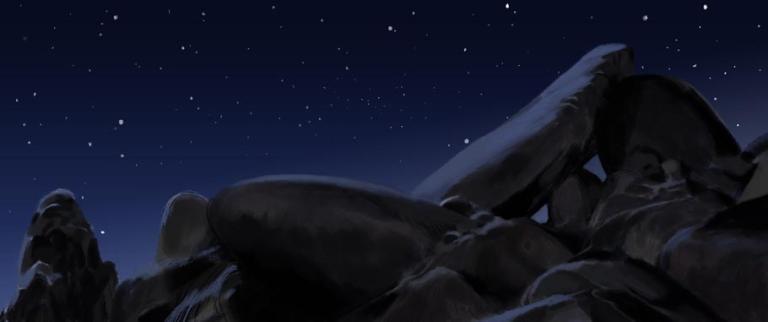 If you haven’t seen the Oscar-nominated animated short Adam and Dog yet, you really should. It’s a beautiful, inspired and, in its own way, challenging take on the story of the Garden of Eden, as seen from the limited — but still keenly felt — perspective of the world’s first domesticated canine.
If you haven’t seen the Oscar-nominated animated short Adam and Dog yet, you really should. It’s a beautiful, inspired and, in its own way, challenging take on the story of the Garden of Eden, as seen from the limited — but still keenly felt — perspective of the world’s first domesticated canine.
I loved it from the moment it was first posted online two weeks ago, and I saw it again a couple days later, this time on the big screen, where it was screened as part of the touring Oscar Nominated Short Films program.
Ben Sachs at the Chicago Reader notes that the film works very well in both formats:
Lee often presents untouched creation in extreme long shot—or what would be called extreme long shot in live-action filmmaking—taking full advantage of the widescreen frame to suggest endless open space. Working in vistas also permits Lee and his animators to create impressive locations with relatively little detail; the fields, mountains, and forests of Eden register as imposing shapes, further evoking a mythic perspective. In contrast John Maximillian Repka’s sound design is more particular, employing field recordings of wild environments that imbue the film with a sense of realism. Perhaps it’s the influence of Tarkovsky that inspired Lee to make the most realistic attribute something we cannot see.
Of the five Oscar nominees for best animated short, this is the only one that demands to be viewed on a big screen. On a laptop, however, Lee’s inspired simplicity becomes more apparent. The design of Adam and Dog owes as much to watercolor painting as to filmmaking; to achieve its full effect, the viewer must add to it with their own imagination. This aptly recalls the experience of first hearing Bible stories as a small child, when concepts like Eden or eternity seemed not just palpable, but warmly inviting.
Amen to all that. And speaking of those “vistas”, director Minkyu Lee, who made the film in his spare time while working on Disney films like Winnie-the-Pooh and Wreck-It Ralph, gave Cartoon Brew permission to post fifteen of the background paintings he used in his film. Here’s one example:
In my original post on the film two weeks ago, I mentioned that I didn’t know much about the religious background, if any, of the people who made this film, beyond a reference that Lee had made to “my faith” and the fact that one of the consultants, Disney legend Glen Keane, is a practising Christian.
Since then, I have found this fascinating interview with the Animation World Network, in which Lee says one of the key themes of the film — a theme to which Keane himself contributed significantly — is “Grace”:
DS: Right. Tell me a little bit about the tone you wanted to take with the story. Were you trying to play down the potential “religious” aspect of the film?
ML: That’s a really good question. It’s really interesting you say that because I’ve been getting very different responses in context to and related to the religious themes of the film. Some people have said, “Wow, that was a very religious and spiritual film” while some people didn’t notice any religious theme at all. It’s delightful to me to hear such a wide variety of responses for one film.
I consider myself a man of faith. Because my faith is a huge part of who I am, I’m sure it leads into everything I create and every decision I make. It does color my world view and it does color my art. So inevitably, I’m sure whether I deliberately tried to put it [themes of faith] in there or not, it’s probably there.
I didn’t want this to be an overtly religious film by any means. I wanted this to be more of a character study, a film that takes an alternative approach to the narrative of an animated film. I worked with two film consultants on the film. One was Glen Keane and the other was Thomas Ethan Harris. I would think they have widely differing faiths. Both approached the film in a different way. I went to Glen a lot to talk about the film. One thing that Glen mentioned, which was a huge part of the film, was the idea of “Grace.” The idea of Grace is such a huge part of my faith. But I think Grace is also a universal element, an idea that is integral to human living. So in terms of the ending of the film, I didn’t want anything to be overt, even the idea of Grace. I didn’t want it to be overtly sentimental or emotionally punctuated. I wanted everything to have this subtle kind of nuance. Glen would use the word “Sprezzatura,” which means this kind of nonchalance. I wanted the film to have that. I wasn’t really trying to do anything overt. Amongst my animators, some of their approaches to the film were very overtly related to their faith and some not at all. Ideally, that’s what I want from this film. I want everyone to discover something different when they watch the film. I don’t want everyone to walk away thinking exactly the same thing, drawing exactly the same conclusion.
I find this comment particularly fascinating in light of the note on which the film ends. In my previous blog post, I said the film almost seems to suggest that one of God’s creations — the dog — might love Adam and Eve more than their Creator does.
But I would emphasize the word “seems”: in that moment, Adam and Eve have just fled the fallen Eden in terror, and they may feel that they have been rejected, in some sense, by God — so of course the fact that the dog stays with them is comforting in a way that God’s judgment is not.
And yet, could not the fact that the dog stays with them be, in some sense, a sign that God is still present in his creation (fallen though it may be) and is thus present with Adam and Eve themselves? Just as God clothed Adam and Eve to cover their nakedness, so too he gives them an enduring expression of unconditional love, as embodied in this animal who stays by their side.
For some reason I am now reminded of the Terry Scott Taylor song ‘Molly Is a Metaphor’, which is about a cat, not a dog, but still kind of fits, I think:
Anyway, like I said above, if you haven’t seen the film yet, you should.
Alas, that will be a little more difficult now than it was two weeks ago, because most of the Oscar-nominated shorts — including the video that I embedded in my earlier post — have been yanked off YouTube following a request from the company that is backing the current theatrical screenings.
You can still find it online, though, in one form or another. So see it!
In the meantime, I’ll be crossing my fingers and hoping that this film’s name is called when the envelope is opened during the Academy Awards ceremony this Sunday.













